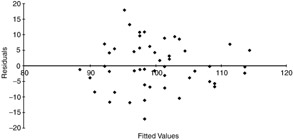JUDGING THE SIZE OF THE RESIDUALS
How can you tell whether a residual is big or small? If I tell you that a case has a residual of 500, can you say whether the model gives a reasonably good prediction for the case? On first thought, 500 seems to be a pretty large number ” an indication that a model does not fit that case. However, if you are predicting income in dollars, a residual of 500 may not be all that large. Predicting a person's income to the nearest 500 dollars is pretty good. On the other hand, if you're predicting years of education, a residual of 500 should send you searching for a new and improved model. One way to modify the residuals so that they would be easier to interpret is to standardize them. That is, divide each residual by an estimate of its standard deviation.
How come you are only dividing the residual by its standard deviation? Why you are you not first subtracting off the mean, as you did before, when computing standardized values? You do not need to subtract the mean of the residuals before dividing by the standard deviation because the mean of the residuals is zero. If you add up all of the residuals, you will find that their sum, and therefore their mean, is zero. That is always true for a regression model that includes a constant.
For most cases, the standardized residuals range in value from -2 to +2 and they are identified as *ZRESID. (Remember that in a normal distribution with a mean of 0 and a standard deviation of 1, about 95 percent of the cases fall within +2 and -2.) Whenever you see a standardized residual larger than +2 or smaller than -2, you should examine the case to see if you can find some explanation for why the model does not fit. A typical presentation of residuals in a standardized format is shown in Figure 9.4.

Figure 9.4: Typical residuals in a standardized format.
EAN: 2147483647
Pages: 252